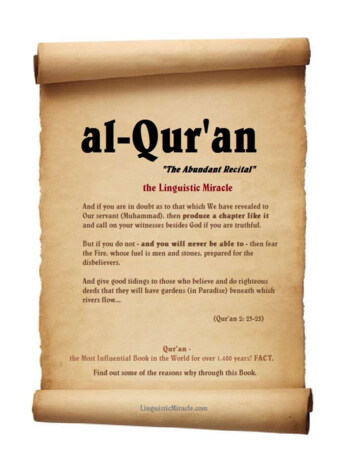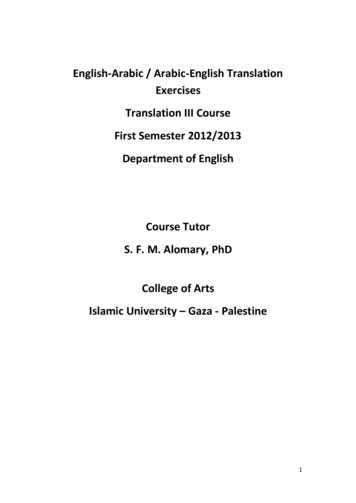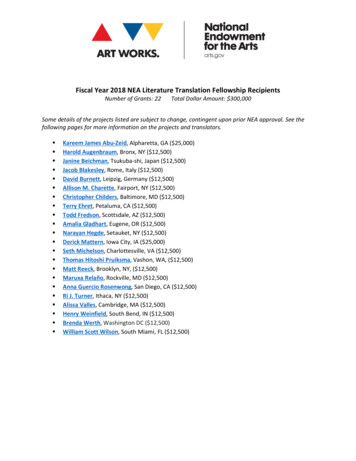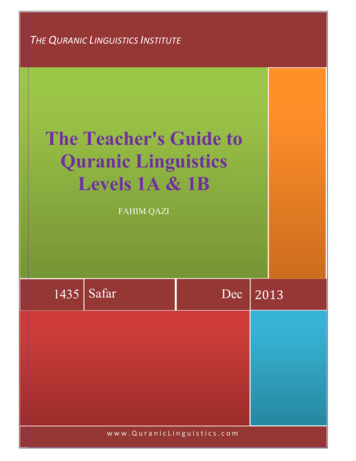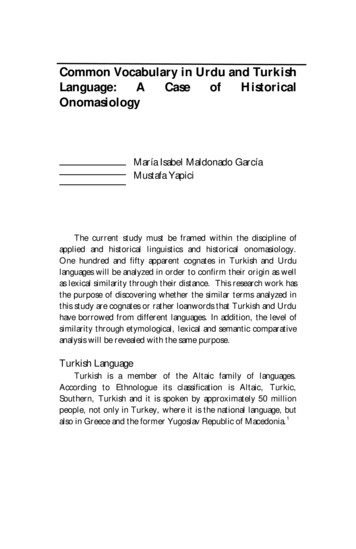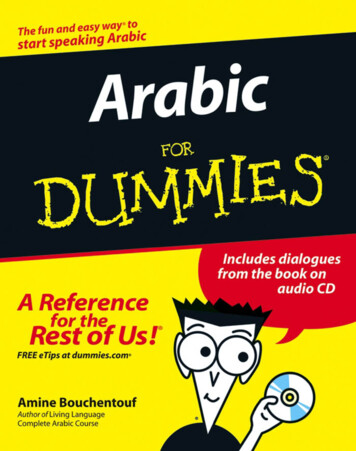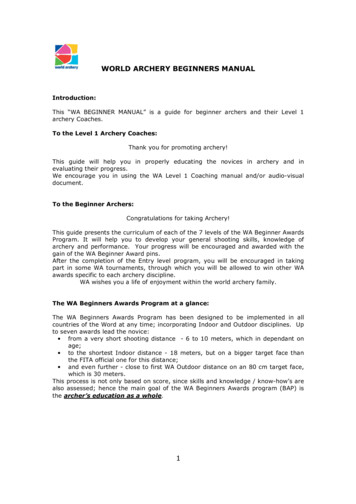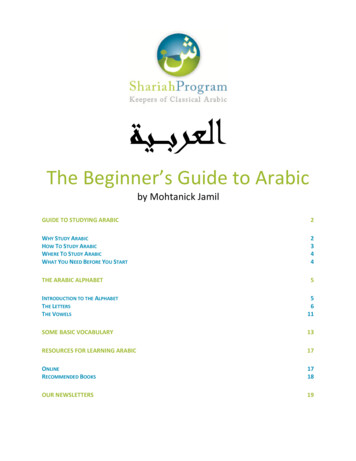
Transcription
اﻟﻌﺮﺑ ـ ـﻴﺔ The Beginner’s Guide to Arabicby Mohtanick JamilGUIDE TO STUDYING ARABIC2WHY STUDY ARABICHOW TO STUDY ARABICWHERE TO STUDY ARABICWHAT YOU NEED BEFORE YOU START2344THE ARABIC ALPHABET5INTRODUCTION TO THE ALPHABETTHE LETTERSTHE VOWELS5611SOME BASIC VOCABULARY13RESOURCES FOR LEARNING ARABIC17ONLINERECOMMENDED BOOKS1718OUR NEWSLETTERS19
Guide to Studying ArabicWhy Study ArabicArabic is spoken as a mother tongue by between 250 and 400 million people across 25 countries. Over abillion people can read the script even if they can’t understand the language. And Arabic happens to beone of the official languages of the United Nations. Therefore, many people learn the language forformal reasons.At about 1,500 years old, Arabic also happens to be a very old language. It was the language ofscholarship throughout the rule of the Islamic empires – a period of well over 1,000 years from the 7thcentury right down to the 19th and even 20th. The greatest books of medicine, geology, law, philosophy,and basically any subject you can imagine were all written in the finest Arabic. Therefore, many of themost advanced people in their fields of study learn Arabic for scientific and anthropological reasons.Arabic is also the language of the Qur’an (the Islamic holy book). It doesn’t matter what your beliefs are,the Qur’an is unequivocally, undeniably and undoubtedly the greatest form of Arabic literature, andindeed the greatest form of literature, period. The beauty of this piece of literature is, in fact, quiteliterally, miraculous. Therefore, tens of millions of people learn this language to witness firsthand thebeauty and miracle that is The Qur’an. religious reasons.In fact, emphasis has been placed on studying the Arabic language by the Prophet (PBUH) himself whenhe said to the effect: learn the Arabic language as you learn the Islamic obligations and practices. Hiscompanions, who, remember, were Arabs, used to learn Arabic despite the fact that it was their mothertongue. They used to say: teach your children Arabic. They used to correct each other’s grammar. Theywould consider it unacceptable to make a grammatical mistake. And the scholars that followed them inlater centuries all emphasized learning Arabic. Imam Abu Hanifa said to the effect: I would’ve madelearning this language compulsory had I not deemed it difficult on the people.That is because1. in order to truly understand the message of God as it was revealed, one must understand it inthe very language it was revealed, and2. the Qur’an is a literary miracle – really, a full blown miracle – and in order to witness it, youneed to simply learn the language and you will witness a miracle with your very own eyesWhen the tribe of Qureish in ancient Arabia sent their most infamous debater to the Prophet (PBUH),the debater barked and barked and barked. He was enthusiastic and completely vicious. His mission wasto completely overtake the Prophet (PBUH) and he was relentless. But when he finished, the Prophet(PBUH) recited a few verses of the Qur’an, upon which tears started to flow from the debater’s eyes andhe had to cover the Prophet’s (PBUH) mouth because he couldn’t take any more. Would you like to tastethe same beauty that made that debater cry?
How To Study ArabicHow you study the language depends largely on why you’re studying it. If you’re studying the languageto be able to communicate informally with friends, for example, then the best place to start for thispurpose is to enrol in a short term class (about 6 months to 1 year) where you will be taught a colloquialdialect of Arabic. There are many dialects, but the Egyptian is most popular and most widely recognized.Whether the course is in person or online doesn’t make a difference in our opinion. But the course musthave a live teacher of native Arabic descent, offer plenty of conversational practice and place highemphasis on out-of-class work. These are courses that get their students to watch subtitled movies, pairthem with native speakers for practice and even offer exchange and immersion programs.If you are studying the language for formal purposes, on the other hand, you will need a more formalregiment. You will be relying more on books and placing more attention on grammar rather than yourability to speak fluently. The ability to speak casually and fluently will come later. And the studies willlast longer than a year or two; perhaps as much as 4 years.Most universities and colleges offer Arabic language courses. Some even span 3 or 4 years. Most ofthese are quite good and will give you a firm grounding in Modern Standard Arabic to the point whereyou can eventually acquire a formal position such as translator, etc. But remember, just because there ismore emphasis on grammar, doesn’t mean you don’t have to practice. You will need to set aside severalhours for practice and eventually work on your ability to converse in Arabic.A note of caution: The wrong thing to do when studying Arabic formally is to purchase a few books andstart learning on your own. Many books claim that you can use them for self-learning, but let’s get real.What you need is a medium or long term course with plenty of hours of instruction and lots of practiceon your own time. Pick the course and/or book that’s most convenient for you, but don’t try to do it allon your own.Finally, if you are studying Arabic in order to understand the Qur’an or works of classical scholarship,you will need to master Classical Arabic. There are several courses around the world that offer masteryin Classical Arabic, but it is not worth quitting your job and joining these schools full time. What is best isa medium or long term online course with teacher interaction. You will be relying heavily on books andwill need to prepare for each lesson by reading ahead before classes.You will cover at least 5 different subjects just on the Classical Arabic language:1.2.3.4.5.6.7.Grammar –phrases and sentencesMorphology and Etymology – verbs and conjugationCantillation – pronunciationLiterature – practice, exposure to different styles of writing, idiomsLogic – a prerequisite for further studiesRhetoric – literary devices and beautifying speechPoetry – an understanding of Arabic poetry and culture
Where To Study ArabicAs mentioned, the wrong thing to do is to try and study on your own. You need to join a class. If youstudy informal or formal Arabic, a university or college course is usually the safest bet. Find a collegenear you and read up on their Arabic programs. There are a few good online courses out there, but theyare a bit dodgy and not necessarily as well established.If you are studying Classical Arabic, you probably have only two choices: 1) join a full time program thatwill require you to take a few years off of work and pause your life, or 2) take a part-time course online.You may be thinking of attending a college or university course part time or learning from a nativespeaker for Classical Arabic. But don’t be fooled. Although Modern Standard Arabic and Classical Arabicare very similar, understanding the Qur’an and the depths of Classical Arabic cannot be done so easily;universities are not equipped to deal with this and native Arabs don’t necessarily understand thelanguage at this level.You need the absolute best education by the absolute best teachers in the most advanced manner.Regular courses can’t give that to you and native Arabs speak the language but they don’t necessarilyunderstand its most intricate details. you need a proper method.What You Need Before You StartMost courses and books assume you already know the alphabet and can read and write Arabic. And to alarge extent, this is a valid assumption because most students have been reading the Qur’an sincechildhood.But not all students are Muslim and have been reading since childhood. Moreover, when learning theQur’an as a child, most Muslim children were not taught in a correct manner. It is vitally important tolearn reading and writing skills even if you already read the Qur’an.Here we have given you just a basic crash course on the Arabic alphabet and reading/writing to get youstarted. You are highly encouraged to take a course on Arabic script. Remember, even if you read theQur’an or even if you are an Arab, if your goal is to understand the Qur’an then you need the mostadvanced Arabic. And reading, writing and the alphabet are no exception. you need to relearn thesethings the right way.To take the Arabic alphabet crash course, scroll to the next section.
The Arabic AlphabetIntroduction to the Alphabet Arabic is read from right to leftAlmost all the letters in an Arabic word are joined together like hand writingSome letters can’t join because of their shape, but we’ll see them as they comeThere are 29 letters in the Arabic alphabetThere is no such thing as capital letters versus small lettersThere is no such thing as printing versus hand writing, Arabic is all hand writingAll the letters in the alphabet are consonantsVowels are separate marks that go on top or underneath these lettersThe letters are shown below ج ث ت ب ا Jeem (J)Thaa (TH)Taa (T)Baa (B)Aleph (A) ر ذ د خ ح Raa (R)Dhaal (DH)Daal (D)Khaa (KH)Haa (H) ض ص ش س ز Daad (D)Saad (S)Sheen (SH)Seen (S)Zaa (Z) ف غ ع ظ ط Faa (F)Ghein (GH)Ein (?)Zaa (Z)Taa (T) ن م ل ك ق Noon (N)Meem (M)Laam (L)Kaaf (K)Qaaf (Q) ي ء ه و Yaa (Y)Hamza (A)Haa (H)Waw (W)Each letter has 4 forms (which look very similar to each other)o when you write the letter by itselfo when it comes in the beginning of a wordo when it comes in the middle of a wordo when it comes at the end of a wordThe forms you saw in the chart above are when the letter is by itselfo here’s an example of the letter Baa in all 4 forms
endmiddlebeginningby itself ـﺐ ـﺒ ـ ﺑـ ب These are the vowels in the languageِ ـ Kasra (E)َ ـ ُ ـ Fat-ha (A)Damma (U)ٍ ـ ً ـ ٌ ـ 2 Kasra (EN)2 Fat-ha (AN)2 Damma (UN) ـِ ْﻲ ـﺎ ـُْﻮ Yaa (EE)Aleph (AA) ـَ ْﻲ Yaa Leen (EI)Waw (UU) ـُْﻮ Waw Leen (AW)The Letters The first letter of the Arabic alphabet is AlephRemember that all 29 letters in the alphabet are consonants. well, this is not exactly true forAleph. Aleph doesn’t have its own sound; it is used to stretch the short A vowel to form the longAA vowelThis is how the Aleph looks in the four casesendmiddlebeginning of a wordby itself ـﺎ ـﺎ ـ اـ ا Notice that the Aleph cannot connect to the letter after it. There will be a small gap between theAleph and the next letterAleph is one of 6 letters that cannot connect to the following letter. The other 5 will bediscussed laterThe next letters of the Arabic alphabet are Baa, Taa and ThaaWe are grouping these letters together because the basic shape of the letters looks the same;only the dots are different
Baa corresponds to the English BTaa corresponds to the English T, but it’s softerThaa corresponds to the combination TH, as in “thank”The 4 forms of these letters are the same; the only difference is the number and position of dotsendmiddlebeginningby itself ـﺐ ـﺒ ـ ﺑـ ب ـﺖ ـﺘ ـ ﺗـ ت ـﺚ ـﺜ ـ ﺛـ ث The next letters are Jeem, Haa and KhaaJeem corresponds to the English JHaa corresponds to the English H, but it’s much more throatyKhaa corresponds to the combination KHIn writing, Jeem, Haa and Khaa each have the same body, as followsendmiddlebeginningby itself ـﺞ ـﺠـ ﺟـ ج ـﺢ ـﺤـ ﺣـ ح ـﺦ ـﺨـ ﺧـ خ The next letters of the alphabet are Daal and DhaalDaal sounds like the letter D in English, but softerDhaal sounds like the combination TH, as in “that”This is how these two letters look in their 4 forms.Notice that Daal and Dhaal do NOT connect to the following letterendmiddlebeginningby itself ـﺪ ـﺪ ـ دـ د ـﺬ ـﺬ ـ ذـ ذ The next letters of the alphabet are Raa and Zeiy
Raa sounds somewhat like the letter R in EnglishZeiy sounds like the letter Z in EnglishThe name of the letter Zeiy is sometimes pronounced Zeiy (“Zaa-ee”) or even Zayen (“Zaa-yen”)Raa and Zeiy have the same bodyRaa and Zeiy do NOT connect to the following letterendmiddlebeginningby itself ـﺮ ـﺮ ـ رـ ر ـﺰ ـﺰ ـ زـ ز The next letters of the alphabet are Seen and SheenSeen is equivalent to the letter SSheen is equivalent to the combination SHSeen and Sheen look very similar except that Seen has no dots and Sheen has 3 dots on topendmiddlebeginningby itself ـﺲ ـﺴـ ﺳـ س ـﺶ ـﺸـ ﺷـ ش The next letters of the Arabic alphabet are Saad and DaadSaad sounds like the letter S, but it has more of a whistleDaad sounds like the letter D, but much, much thicker and deeper soundingSaad and Daad look very similar except that Saad has no dots and Daad has one dot on topendmiddlebeginningby itself ـﺺ ـﺼـ ﺻـ ص ـﺾ ـﻀـ ﺿـ ض The next letters of the Arabic alphabet are Taa and ZaaTaa is not the same as the one we saw earlierIt sounds like the letter T, but it is much, much thicker soundingZaa is not the same as the one we saw earlierIt sounds like the letter Z, but it is much, much thicker soundingTaa and Zaa look very similar except that Taa has no dots and Zaa has one dot on topendmiddlebeginningby itself
ـﻂ ـﻄـ ﻃـ ط ـﻆ ـﻈـ ﻇـ ظ The next letters of the Arabic alphabet are Ein and GheinEin doesn’t have an English equivalent; it is a very throat soundGhein sounds like the combination GH, like the noise when you gargleEin and Ghein look very similar except that Ein has no dots and Ghein has one dot on topendmiddlebeginningby itself ـﻊ ـﻌـ ﻋـ ع ـﻎ ـﻐـ ﻏـ غ The next letters of the Arabic alphabet are Faa, Qaaf and KaafFaa is equivalent to the English letter FQaaf is represented by the letter Q; it sounds like K except it’s more throatyKaaf is equivalent to the English letter KThis is what these letters look like in all 4 formsendmiddlebeginningby itself ـﻒ ـﻔـ ﻓـ ف ـﻖ ـﻘـ ﻗـ ق ـﻚ ـﻜـ ﻛـ ك The next letters of the Arabic alphabet are Laam, Meem and NoonLaam is equivalent to the English letter LMeem is equivalent to the English letter MNoon is equivalent to the English letter NThis is what these letters look like in all 4 formsendmiddlebeginningby itself ـﻞ ـﻠـ ﻟـ ل
ـﻢ ـﻤـ ﻣـ م ـﻦ ـﻨ ـ ﻧـ ن When Laam is followed by Aleph, the Aleph curves a bit, like this ﻻ Another speciality is the word Allah. which is written very uniquely, as followsAleph, Laam, Laam, Aleph, Haa (which we haven’t seen yet) اﷲ The rest of the letters of the Arabic alphabet are Waw, Haa, Hamza and YaaWaw is equivalent to the English letter WHaa is equivalent to the English letter H, not to be confused with the Haa we saw earlierHamza is equivalent to the English letter A, as in “apple” (not considered a vowel, though)Yaa is equivalent to the English letter YThis is what these letters look like in all 4 formsendmiddlebeginningby itself ـﻮ ـﻮـ وـ و ـﻪ ـﻬـ ﻫـ ه ءأإؤئ ـﻲ ـﻴ ـ ﻳـ Sometimes Haa is written with 2 dots on top; this is actually the letter TaaThis can only happen at the end of a wordendmiddlebeginning ـﺔ ي Writing Hamza is very complicated, so we’ll leave it for nowby itself ة
But essentially, it can be written by itself, on top of a Waw, on top of an Yaa, or on top or belowan AlephYou will sometimes see Yaa without its dots; this is actually an AlephThis can only happen at the end of a wordendmiddlebeginningby itself ـﻰ ى The Vowelsِ ـ Kasra (E)َ ـ ُ ـ Fat-ha (A)Damma (U)ٍ ـ ً ـ ٌ ـ 2 Kasra (EN)2 Fat-ha (AN)2 Damma (UN) ـِ ْﻲ ـﺎ ـُْﻮ Yaa (EE) ـَ ْﻲ Yaa Leen (EI)Aleph (AA)Waw (UU) ـُْﻮ Waw Leen (AW) Arabic has 3 short vowels: U, A and E/IThese are marks that go on top or underneath a letterIf a letter has a vowel, it means that vowel comes after that letter You can “double” these vowels; this will add the sound of the letter N at the endThis doubling can only happen at the end of a word If a letter has no vowel after it, we put a special symbol on top of that letter to indicate thisThis symbol is called a SukoonIf there is a letter with a Sukoon and then the same letter in the same word again, the twoletters will be written as one and a special symbol will be placed on top of the letterThis symbol is called the ShaddaThe vowel of the second letter is placed on top of underneath the Shadda, not on top ofunderneath the letter itself
ّ ـ Shadda (same letter twice)ْ ـ Sukoon (no vowel) The letters Aleph, Waw and Yaa can act as long vowelsThe Aleph stretches the Fat-ha vowel to form a long AA soundThe Waw stretches the Damma vowel to form a long OO soundThe Yaa stretches the Kasra vowel to form a long EE soundSo Aleph must always have a Fat-ha before itSimilarly if Waw is acting as a long vowel, it will have a Sukoon on it and a Damma before itAnd if Yaa is acting as a long vowel, it will have a Sukoon on it and a Kasra before it Waw and Yaa can also act as semi-vowelsWaw can form the semi-vowel AW / OW, as in “Howl”Yaa can form the semi-vowel EI, as in HusseinThis will happen if they have a Sukoon on them and a Fat-ha before them
Some Basic VocabularyGeneral ConversationArabicPronunciationMeaning اﻟﺴﻼم ﻋﻠﻴﻜﻢ as-salaam alaeikumpeace be with you (formal greeting) ﻛﻴﻒ ﺣﺎﻟﻚ؟ keifa haalukhow are things? (formal) ازﻳﻚ e-zayyakwhat's up? (informal) اﳊﻤﺪ ﷲ al-hamdu lillahpraise God (formal answer) أﻧﺎ ﲞﲑ ana bi kheirI'm good (formal answer) ﻛﻞ ﲤﺎم / ﲤﺎم tamaam / kullu tamaameverything's good (informal answer) ﻗﻮﻳﺲ q-wayyisfine / pretty good (informal answer) ﺷﻮ أﺧﺒﺎر اﻟﻌﻤﻞ؟ shoo akhbaar al-amalhow's work? (informal) اﻟﺴﻼم ﻋﻠﻴﻜﻢ as-salaam alaeikumpeace be with you (formal goodbye) ﻣﻊ اﻟﺴﻼﻣﺔ ma'as-salaamabye (literally: with safety) (semi-formal) ﺑﻌﺪﻳﻦ ba'deinlater (see you later) (informal) ﰲ ﻣﺎ ﺑﻌﺪ fee maa ba'dafter/in a while (informal) ﻣﻦ أﻳﻦ أﻧﺖ min ayna antawhere are you from? (formal) وﻳﻦ / أﻧﺖ ﻣﻦ ﻓﲔ anta min fein/weinwhere are you from? (informal) ﻣﺎ اﻟﺴﺎﻋﺔ؟ mas-saa'awhat time is it? (formal) اﻟﺴﺎﻋﺔ ﻛﻢ؟ as-saa'at kamwhat time is it? (informal)ArabicPronunciationMeaning ﻣﻄﺎر mataarairport ﻃﻴﺎرة tayyaaraairplane وﺻﻮل wusoolarrival ﻣﻐﺎدرة mughaadaradeparture ﺎرك ا al-majaarikcustomsTravelling
ﻣﺘﺎع mataa'luggage ﺟﻮاز اﻟﺴﻔﺮ jawaaz as-safarpassport ﺗﺄﺷﲑة ta'sheeravisa ﺗﺬﻛﺮة tazkiraflight ticket ﻓﻨﺪق funduqhotel اﺳﺘﻘﺒﺎل istiqbaalreception ﻣﻔﺘﺎح miftaahkey ﻏﺮﻓﺔ ghurfaroom ﺻﺮاف sarraafcurrency exchangeArabicPronunciationMeaning ؟ . ﻣﺎ maawhat is .? ؟ . ﻣﻦ manwho is .? ؟ . أﻳﻦ aynawhere is .? ؟ . ﻣﱴ mataawhen is .? ؟ . ﻛﻢ kamhow much is .? ﻛﻢ ﻫﺬا؟ kam haazahow much is this? ؟ . ﻛﻴﻒ keifahow .? ﳌﺎذا؟ li maazawhy اﻟﺴﺎﻋﺔ اﶈﻠﻴﺔ as-saa'al mahalliyathe current timeAsking QuestionsCounting & NumbersArabicPronunciationMeaning واﺣﺪ waahid1 اﺛﻨﺎن ithnaan / ithnein2 ﺛﻼﺛﺔ thalaatha3 أرﺑﻌﺔ arba'a4
ﲬﺴﺔ khamsa5 ﺳﺘﺔ sitta6 ﺳﺒﻌﺔ sab'a7 ﲦﺎﻧﻴﺔ thamaania8 ﺗﺴﻌﺔ tis'a9 ﻋﺸﺮة ashara10 أﺣﺪ ﻋﺸﺮ ahada ashar11 اﺛﻨﺎ ﻋﺸﺮ ithna ashar12 ﺛﻼﺛﺔ ﻋﺸﺮ thalaatha ashar13 أرﺑﻌﺔ ﻋﺸﺮ arba'a ashar14 ﻋﺸﺮ . ashar.-teen ﻋﺸﺮﻳﻦ ishreen20 ﺛﻼﺛﲔ thalaatheen30 أرﺑﻌﲔ arba'een40 ﲬﺴﲔ khamseen50 ﺳﺘﲔ sitteen60 ﺳﺒﻌﲔ sab'een70 ﲦﺎﻧﲔ thamaaneen80 ﺗﺴﻌﲔ tis'een90 ﻣﺌﺔ / ﻣﺎﺋﺔ mi-a100 و wawahid wa ishreenand(1 and 20 21)ArabicPronunciationMeaning١waahid1٢ithnaan / ithnein2٣thalaatha3٤arba'a4
shara10ArabicPronunciationMeaning اﲰﻚ إﻳﻪ؟ ismak ehwhat's your name? (informal) ﻣﻄﻌﻢ mat'amrestaurant ﲪﺎم hammaambathroom أﺟﺮة ujrataxiOther
Resources for Learning mlA great series of lessons on learning to read and write Arabic from scratch. The lessonsare fun to read, very easy to go through and take you step by step at your own pace.Lessons include audio and exercises are provided. It has been called one of the bestfree Arabic alphabet courses on the Internet! Try it yourself.BeginnersFREEhttp://www.learnarabic.caGo from knowing absolutely nothing about Arabic to reading, writing and pronouncingbetter than scholars through this video course. Watch with the family at your owntime. Go as slow or as fast as you want. Learn to pronounce each and every letterperfectly, watch how to write each letter, get step-by-step guidance on learning how toread sentences. This is a great investment for any serious student of classical Arabic.Beginners; also good for intermediateCheck website for pricehttp://www.shariahprogram.caA world class course for students who already know how to read Arabic. This is whatbeginners, intermediates and even advanced students go to Syria for. This is one of thehottest courses for learning Arabic. Get live instruction on grammar, morphology,literature, analysis of Qur'an and much more through this online course. Take the trialand see for yourself.Beginners, intermediate and advancedCheck website for pricehttp://www.learnarabiconline.comA huge collection of approximately 100 tutorials on all aspects of classical Arabicgrammar, morphology, syntax and other topics. A perfect studying aid for intermediatestudents and a great refresher for advanced er/ArabicLikeABossA YouTube channel with short videos on topics in Arabic rhetoric (Balaagha). There isnothing quite like this on the Internet. The most advanced topics in Arabic rhetoric arepresented in a way that is accessible to everyone. Get insight into the most amazingaspects of this language and learn to see the beauty in the Qur'an. Subscribe today.Advanced (but also interesting for intermediate and beginners)FREE
Recommended Books1Description:Alif Baa With Multimedia: Introduction to Arabic Letters and Sounds (Arabic Edition)The first in a series of books that deal with Modern Standard Arabic, and even someEgyptian colloquial. This volume goes through reading, writing and pronunciation.Improve your penmanship and learn some new vocabulary while you're at it.2Description:Al-Kitaab fii Ta'allum al-'Arabiyya with DVDs: A Textbook for Beginning Arabic, Part OneThe second book in the series that deals with Modern Standard Arabic for beginners. Ittakes several months to go throw this book, but it is well worth the effort. The lessonsare well calculated and the exercises are very powerful.3Description:Al-Kitaab fii Ta'allum al-'Arabiyya with DVDs: A Textbook for Arabic, Part TwoThe third book in the series for intermediate students.4Description:Al-Kitaab fii Ta allum al- Arabiyya with DVDs: A Textbook for Arabic, Part ThreeThe third book in the series for intermediate students.5Description:Hans Wehr dictionaryThe most popular dictionary for the Arabic language, suitable for modern Arabic as wellas classical. If you're several months into your courses, you will not be moving onwithout this gem.
Our NewslettersWe are thrilled that you decided to join our community of Arabic language enthusiasts! We want you tobe on your way to understanding Arabic and the Qur’an.As you may know, we are fortunate to have Mohtanick Jamil author a monthly newsletter deliveredexclusive by us. And because we value your membership in this community so much, we want to makeavailable to you all the issues of this newsletter that you’ve missed. It’s just our way of saying THANKYOU and WELCOME.Scroll down to see the past issues of our newsletter, The Caravan Press.
The Caravan PressIssue 1The Significance of the Arabic Languageby Mohtanick JamilPopularity:Arabic is an official language in over 25 countries across NorthAfrica and the Middle East, putting it in third place behind English andFrench.Arabic is also one of the 5 official languages of the UN.It boasts between 300 and 400 million native speakers andhas over 1.2 billion people that can read its script.This language was spoken in its classical form as early as 2millennia ago and remains vibrant in cultures spanning 2 continents aswell as in scholarly circles as the liturgical languageof Islam. As such, Arabic has enjoyed countlessmillions of works of scholarship throughout thecenturies.Arabic has also contributed to many otherlanguages. It has given English, for instance, thefollowing familiar words: admiral, alcohol, algebra,algorithm, almanac, apricot, arsenal, candy,chemistry, coffee, cotton, gazelle, giraffe, hazard,lemon, lime, magazine, racket, safari, sofa, sugar,syrup, zero and many others.Calligraphy:The Arabic script is a veryunique and magnificent form of art.Few other languages have venturedto take their calligraphy to thisextent, to the point where itbecomes art in its own right.The various forms ofcalligraphy are basically divided into6 types. Naskh is the simplest andmost straightforward. Muhaqqaqand Rayhani are also quite simple excepting that letter endings areexaggerated and extended. Riqa and Tawqi are characterized by longThe phrase Bismillah by Hassan Musalines and large loops. And Thuluth is arguably the most exaggerated ofall the above major forms.But it was major influence from other regions such as Persiawhich gave even more outrageous exaggeration to the script, making itthe marvel that it is today.Liturgy:The two sources of Islamic scholarship are the holy Qur’anand the codified tradition of the prophet (PBUH). Both sources are inthe Arabic language. And the first generations ofdisciples were also Arabs. As such, most ofIslamic scholarship is done within the confines ofthis language.Moreover, history sees many Arabsobliging other Arabs to learn their own languageand listing consequences for not taking the studyseriously.The prophet (PBUH) himself mentioned:learn Arabic as you learn the [Islamic] obligationsand rites.Several of the prophet’s (PBUH) disciplesrepeated this sentiment in other words. Imam Shafi’i, an Arab,mentioned once to his Arabic students: what scares me most is astudent who refuses to learn Arabic grammar. Imam Abu Hanifa isrecorded to have said that he would have made learning Arabic (evenfor native speakers) an obligation had he deemed it feasible.The Secrets of Arabic:In most languages, it would be considered silly to ask certaingrammar questions. For example, asking why the suffix ‘er’, as in‘teacher’, is two letters, why these two letters in particular, why in theorder E then R and why at the end of the word. It’s silly to ask these.But Arabic is an extraordinarily deep language and it answersquestions just like these about its own grammar. These questions andanswers are actually completely memorizing and are closely keptsecrets of the language. They will blow your mind away to the point
The Caravan Presswhere you will yearn to learn the language. Stay tuned for the nextIssue 2issue where we ask and answer one of these questions.Secrets of the Arabic LanguageIntroduction:Arabic is an ancient language with secrets embedded in itsgrammar, vocabulary, etymology and everywhere else. It is like an oldcastle with secret passageways that lead to splendid treasures.The language keeps these secrets very clandestine so veryfew people know about them. But in this issue, we are going to shareone of those secrets with you.This one secret is just the tip of the iceberg. Imagine yourselflearning these secrets more and more and being so enthralled withthem that you feel like quitting your day job and studying the languagefull time. And this is something unique to this magnificent tongue.Remember the ER example:In a previous issue, recall that we talked about how silly itwould be to ask questions regarding English affixes (suffixes andprefixes), for example.Take the ER that comes at the end of words like ‘teacher’ andturns the word ‘teach’ into the person who does the ‘teach’—ing.Imagine how silly someone would sound if they asked whythe ER was two letters, why it was these two letters in particular andnot any others, why it was E then R as opposed to R then E or why theER came at the end as opposed to the E in the beginning and the R atthe end or any other scheme.Asking this is not appropriate in any language. The answer willbe that it just is the way it is. But in Arabic, we can ask these questions.And we will get amazing answers. To truly appreciate these answers, itwould be great if we already spoke Arabic, but let’s dive into thisanyways.The Structure of an Arabic Word is Related to its Meaning:This is the first secret of the Arabic language. The letters aword contains, the order of the letters, the position of those letters,etc, etc all have some relationship with what the word means.by Mohtanick JamilAnd there are so many examples and manifestations of thissecret even in everyday Arabic. We can write entire books on just thisone secret. But let’s focus on one example.Example:We can take almost any Arabic verb and add ST to thebeginning of it. For example, we can add ST to the beginning of fa-hima (to understand). The resulting word is pronounced is-taf-ha-ma (toask a question).Adding ST to the beginning of an Arabic verb changes themeaning of the verb so that, instead of doing that action, now we arelooking to do it. So fa-hi-ma means to understand, but is-taf-ha-mameans to look for understanding, to seek understanding, to ask forunderstanding, etc, etc. This is commonly translated as ‘to ask aquestion’.Notice how the ST indicates on seeking and the fa-ha-maindicates on understanding (in this example), just like how the letters ‘te a c h’ indicate on teaching and the ER indicates on the one who doesit.Now we can ask some seemingly silly questions like: why doesit have to be two letters? Why ST and not anything else? Why ST andnot TS? And why are they in the beginning instead of one in thebeginning and the other at the end, the other in the middle, one in themiddle and the other at the end, etc, etc?Let’s answer the last question: why is the Arabic affix ST at thebeginning of a word?To answer this, remember the secret we learned: the way aword is structured in Arabic has a relationship wit
ﺔﻴــــ ﺑﺮﻌﻟا the beginner’s guide to arabic guide to studying arabic 2 why study arabic 2 how to study arabic 3 where to study arabic 4 what you need before you start 4 the arabic alphabet 5 introduction to the alphabet 5 the letters 6 the vowels 11
